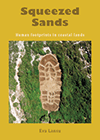PhD defence Eva Lansu
| When: | Tu 20-05-2025 at 16:15 |
| Where: | Academy Building & online |
Eva Lansu (ConsEco)
Promotores: Prof. T. van der Heide, Prof. M.G. Rietkerk (UU); copromotor: Dr V. Reijers (UU)

Squeezed sands
Human footprints in coastal lands
People are drawn to the coast. About one-third of the world’s population lives within 50 kilometers. This popularity brings development of infrastructure and buildings. Meanwhile, sea levels are rising, but this ‘hardening’ leaves no space for coastal ecosystems to retreat inland. This phenomenon, known as coastal squeeze, causes ecosystems to become trapped between rising sea levels on one side and infrastructure development on the other. However, it remains unclear what coastal squeeze means for dune ecosystems. This thesis therefore addresses two central questions: what is the minimal width of a biodiverse dune landscape? And how does that required width compare to the actual space available? To answer these questions, I first quantify to what extent beaches and dunes are being squeezed on a global scale. On average, I find the first paved road or building within 400 meters of the sea. Then, based on field observations, I estimate how much space a biodiverse dune landscape needs. In the Netherlands, dune areas appear to require a width of approximately 3.8 kilometers to reach their full biodiversity potential. However, on average, Dutch dune areas are no wider than one kilometer. As a result, species diversity reaches only 56% of its potential. Thus, coastal squeeze is causing a large-scale loss of dune biodiversity. This, in turn, reduces the resilience of dune ecosystems and threatens their functioning. This is concerning, as human populations depend on these ecosystems for services such as clean drinking water supply and flood protection. To preserve these valuable ecosystems in the long term, it is essential to give dunes space to adapt to rising sea levels. This requires preventing further coastal hardening and, where possible, widening the already narrowed dune areas.
